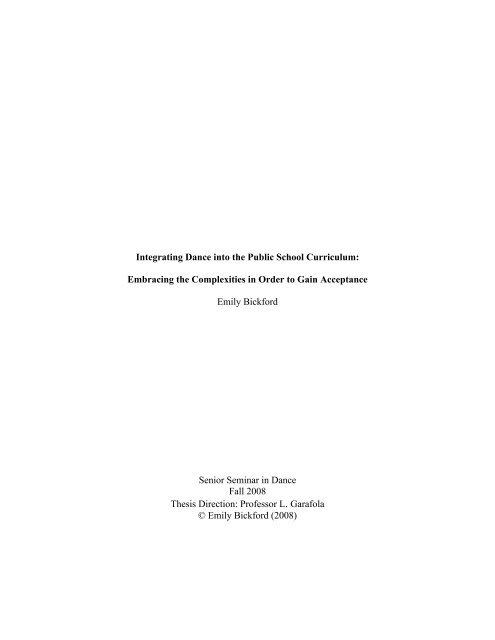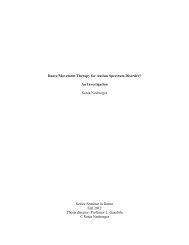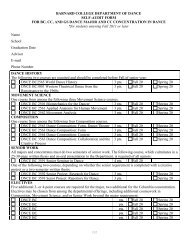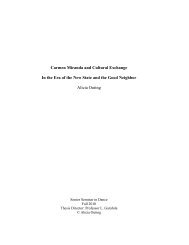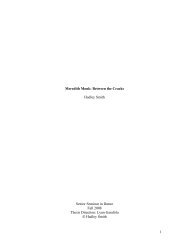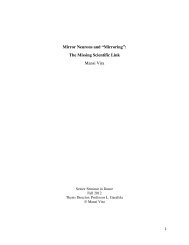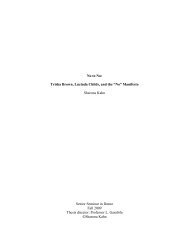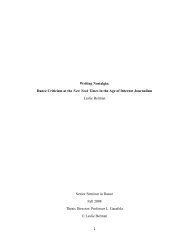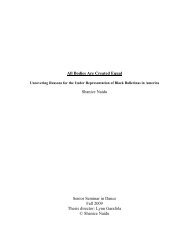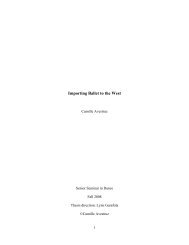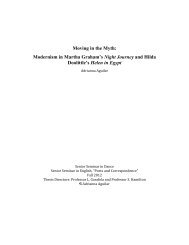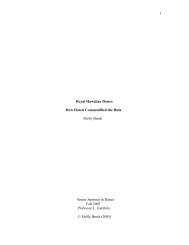By Emily Bickford - Dance
By Emily Bickford - Dance
By Emily Bickford - Dance
Create successful ePaper yourself
Turn your PDF publications into a flip-book with our unique Google optimized e-Paper software.
Integrating <strong>Dance</strong> into the Public School Curriculum:<br />
Embracing the Complexities in Order to Gain Acceptance<br />
<strong>Emily</strong> <strong>Bickford</strong><br />
Senior Seminar in <strong>Dance</strong><br />
Fall 2008<br />
Thesis Direction: Professor L. Garafola<br />
© <strong>Emily</strong> <strong>Bickford</strong> (2008)
Integrating <strong>Dance</strong> into the Public School Curriculum:<br />
Embracing the Complexities in Order to Gain Acceptance<br />
What does the term “dance education” bring to mind? Individually, each word,<br />
dance and education, offers an opportunity for endless interpretation, and the<br />
combination of terms fails to provide any additional simplicity. The diverse perceptions<br />
of dance education and what it can or should be, have led to a trend of narrowing<br />
definitions of dance education as an attempt to focus on, and thus clarify, the benefits of<br />
individual forms. How has this trend affected the successful integration of dance into the<br />
public school curriculum, and what has it meant for the understanding of dance education<br />
as a whole?<br />
Narrowing my own lens so as to find an entry point for exploration of my opening<br />
inquiries, I specifically focus on the way that creative movement has been manipulated to<br />
support dance education’s integration into the public school curriculum. I look at how it<br />
has been transformed by the perceptions of dance education, and also how it has effected<br />
change in the broader definition of dance education. Creative movement becomes a way<br />
of deflecting resistance to dance education’s integration into the public school<br />
curriculum, resistance that has been attributed to teachers’ insecurities with dance and the<br />
misconception that its use in the classroom requires an understanding of its codified<br />
1
vocabulary and base of knowledge. The pairing of the terms, creative and movement, is<br />
recognized for its ability to reduce discomfort for the teacher by dismissing a need for<br />
content knowledge of dance and focusing on the exploratory aspects of movement<br />
instead. This focus on the exploratory benefits of dance is essential to its full acceptance<br />
into the public school curriculum, insofar as all teachers will be able to use dance;<br />
otherwise, this would raise concerns about teacher quality and qualifications to teach a<br />
codified version of dance. The belief is that teachers will feel comfortable using dance in<br />
the classroom once they understand that the argument for dance education implies a use<br />
of dance that is limited to creative movement. The development of this realization,<br />
however, has led to the acceptance of dance in the classroom but would be further<br />
enhanced by emphasizing the benefits of creative movement to student self awareness.<br />
Creative movement, however, is more than just the exploration of one’s own self, insofar<br />
as almost all concepts can be explored kinesthetically, thus potentially supporting the<br />
student’s comprehension of an endless number of subject areas through a kinesthetic<br />
approach. And so a potential, and significant, benefit of using dance in the classroom is<br />
lost in the attempt to alter the definition of dance education in such a way as to respond to<br />
resistance. Insofar as there are bound to be many diverse and even contradictory forms<br />
of resistance to dance education, the full vision of dance’s use in the classroom will be<br />
lost unless dance education takes ownership of its many definitions. This conclusion is<br />
the result of a comparative analysis, between the use of creative movement and humor in<br />
the classroom.<br />
2
While finding numerous benefits supporting the use of creative movement and<br />
humor, I found that dance was able to provide all of the same benefits as humor, and<br />
more. The ability of creative movement and humor to encourage learning suggests the<br />
importance of their widespread acceptance into the classroom. Creative movement and<br />
humor are both beneficial insofar as they are teaching tools that can enhance classroom<br />
learning. More specifically, they increase learning by strengthening the relationship<br />
between student and teacher, and also among students in order to foster an environment<br />
that is conducive to learning. An analysis of these shared benefits, however, will reveal<br />
creative movement as superior to humor in its ability not only to support learning, insofar<br />
as it shapes the student’s environment in a way that makes it more conducive to learning,<br />
but by additionally providing the student with an entirely new, kinesthetic lens through<br />
which to learn. This results in learning that may never have occurred without the use of<br />
creative movement in exploring the content of the main subject area.<br />
Humor and creative movement both support learning by strengthening teachers’<br />
relationships with their students. In an article entitled “Humor as a Teaching Strategy,” a<br />
biology teacher named James Wandersee refers to ideas presented in The Art of Teaching,<br />
a book by Gilbert Highet published in 1950. 1 In the following excerpt, Wandersee is<br />
referring to Highet’s argument, “He maintains that although humor can help students<br />
remain lively and attentive, its real purpose it to link the pupils and the teacher through<br />
enjoyment. Humor can mold a collection of individuals into a group. Togetherness,<br />
1 “Gilbert Highet," Dictionary of American Biography 10: (1976-1980).<br />
3
Highet asserts, is the very essence of teaching.” 2 Thus, we see a teaching strategy, in this<br />
case humor, enhancing learning in the classroom. Wandersee highlights the element of<br />
Highet’s argument that says humor can “link,” or strengthen the bond between student<br />
and teacher; however, he also points out Highet’s claim that humor has the ability,<br />
additionally, to strengthen the relationship between students in the classroom. As<br />
relationships between students grow, so does the potential for communication and shared<br />
exploration, which results in a deeper understanding of knowledge for both or the many<br />
students involved in partner or group work.<br />
<strong>Dance</strong> can also serve as an additional tool for teachers in reaching out to students,<br />
thus increasing the student’s desire to learn. Wrenn Cook, the director of the South<br />
Carolina Center for <strong>Dance</strong> Education, suggests, “<strong>By</strong> using aspects of the dance teaching<br />
process, teachers of all subjects can enliven their delivery of content and reach students<br />
who are unable and often unwilling to learn through the lecture format.” 3 Although Cook<br />
uses the term “dance teaching,” her claim that this includes movement taught in<br />
conjunction with all different subject areas in a classroom setting suggests that she is<br />
actually referring to what I am defining as creative movement. The benefit that Cook<br />
describes implies that creative movement is an additional tool to be used by teachers as a<br />
way of relating to students who may otherwise be overlooked, thus resulting in their<br />
2 James H. Wandersee, “Humor as a Teaching Strategy,” The American Biology Teacher 44 (1982): 212-<br />
218.<br />
3 Wrenn Cook, “Benefits of <strong>Dance</strong> Education in the Middle School Setting,” Journal of <strong>Dance</strong> Education<br />
(2005): 30.<br />
4
increase of learning. Although this benefit is similar to humor in its ability to engage<br />
students’ who may otherwise be lost, it also suggests the appeal of dance. Using<br />
kinesthetic exploration, has a way of helping students understand content in an entirely<br />
new way. This benefit begins to reflect the theory of multiple intelligences by Howard<br />
Gardner of Harvard University, which suggests that people learn in many different ways<br />
and includes “bodily-kinesthetic learning” as one of them. 4<br />
Additionally, we see that both humor and dance promote socialization; however,<br />
dance goes beyond humor’s ability simply to connect children by additionally providing<br />
their relationships with substance based on a shared appreciation of their collaborative<br />
process and subsequent deeper understandings of content, related or unrelated to dance.<br />
In her article “5 to 6: Joking Around,” Ellen Booth Church, an early childhood<br />
consultant, speaks about the ability for humor to encourage socialization as well as an<br />
increase in focus, both of which separately contribute to student’s learning.<br />
When children share a laugh, they bond. Boundaries break<br />
down. They can make friends and be ‘seen’ in a group<br />
giggling over the same common thing with other<br />
children…laughter even increases blood flow to the<br />
brain—after a good laugh, we generally feel energized and<br />
4 Susan Koff, “Toward a Definition of <strong>Dance</strong> Education,” Childhood Education 77 (2000): 4.<br />
5
alert. This can set the stage for learning by helping<br />
children release tension and focus. 5<br />
Church suggests that humor has the ability to bond students, thus releasing tension and<br />
stress, which encourages the student’s ability to gain a deeper level of understanding,<br />
when studying certain content areas. Although she acknowledges that this process<br />
supports the development of students’ learning, her argument cannot be compared to the<br />
argument that dance encourages socialization through collaboration.<br />
Creative movement encourages socialization through collaboration, thus<br />
providing students with a process to bond over, as well as the ability to compare and<br />
share discoveries, thus further strengthening their individual knowledge. Giguere<br />
Miriam, affiliated with the Department of Performing Arts at Drexel University, presents<br />
a study that compares the cognitive processes of children when engaged in dance versus<br />
poetry. In the following passage, Miriam describes a section of the study in which the<br />
students take part in creative dance as a group in order to supplement their<br />
comprehension of the poems “We Real Cool,” by Gwendolyn Brooks, and “Dreams,” by<br />
Langston Hughes.<br />
Students began the choreography in this activity with a<br />
movement phrase they created during the “across the<br />
floor” section of the class…students created movements<br />
to “Dreams” by Langston Hughes, a poem with no<br />
5 Ellen Booth Church, “5 to 6: Joking Around,” Scholastic Parent & Child 12 (2005): 81.<br />
6
narrative and a more abstract, multi-layered message.<br />
Students were encouraged to see from this process how<br />
dance can be more than simply acting out the literal<br />
meaning of the text, and how each individual dancer can<br />
contribute to the creative process. 6<br />
In this passage we see how a more expansive definition of creative movement can thus<br />
increase peer interaction in such a way as to enhance both individual students’ and in this<br />
case, the groups’ comprehension of the subject matter. Interestingly, Miriam also<br />
suggests that this study reveals creative movement’s ability to provide the students with<br />
an entirely new way of viewing the poem and its meaning. In the excerpt we see how<br />
movement helps students to engage with the text in an entirely new way, consequently<br />
providing each student with a new vision of the poem shaped by their own creative<br />
process, as well as the creative process of their peers’. Thus, creative movement, insofar<br />
as it is defined as a teaching tool to be used as an aid in the learning of content even<br />
potentially unrelated to dance, benefits learning by encouraging collaboration among<br />
students. People who have subscribed to the assumption that creative movement is only<br />
a matter of self-exploration, however, would fail to appreciate creative movement’s<br />
ability to increase socialization through collaboration. Although the narrowing of the<br />
definition of dance education is responsible for a loss of potential benefits such as<br />
6 Giguere Miriam, “Thinking as They Create: Do Children have Similar Experiences in <strong>Dance</strong> and in<br />
Langauge Arts?” Journal of <strong>Dance</strong> Education 6 (2006): 41-47.<br />
7
socialization, it is a deliberate reduction based on the belief that the many benefits of<br />
dance are in fact responsible for its resistance.<br />
Thus, although it would be logical to think that the additional benefit of creative<br />
movement above that of humor—to provide students with an entirely new way of<br />
approaching content knowledge—should result in a greater acceptance of creative<br />
movement into the classroom, evidence reveals that such is not the case. Although there<br />
are still teachers skeptical of using humor in their classroom, 7 Arthur Bradford, a<br />
professor at the State University College of Buffalo, argues that humor has become<br />
successfully integrated into teaching. He states, “Savants of education would doubtless<br />
express the idea with more gravity, but they would say something of the same sort.<br />
Whatever is learned, they would say, is better learned…if some ‘pleasure is ta’en’.” 8<br />
Additionally, the sheer amount of resources promoting the use of humor in the classroom,<br />
based on its ability to enhance the focus of students, suggests that the benefits of humor<br />
are common knowledge now. Also, most adults, when asked to refer back to their<br />
“favorite teachers,” will describe some element of respect for that teacher that grew based<br />
on a lively relationship between the student and the teacher. 9<br />
There are also a great number of articles written on the benefits of creative<br />
movement; however, unlike humor, we see that the number of articles written on the<br />
benefits of creative movement reflect a greater need to argue for its importance, rather<br />
7 Sudol, David. “Dangers of Classroom Humor.” English Journal 70 (1981): 26-28.<br />
8 Arthur Bradford, “The Place of Humor in Teaching,” Peabody Journal of Education 42 (1964): 67-70.<br />
9 Phillip Done, “Make 'em Laugh (& They’ll Learn A Lot More),” 115 (2007): 34-35.<br />
8
than confirming its acceptance into mainstream education. Joseph E. Marks III addresses<br />
this struggle in the preface of his book America Learns to <strong>Dance</strong>, “Both <strong>Dance</strong> and<br />
Education are as old as man himself. Both have had their periods of rise and<br />
decline…<strong>Dance</strong>, possibly more than education, has had a rough path to follow, being, at<br />
various ages during the history of man, sometimes an adjunct to religion or a means of<br />
education, as well as a recreation and an art form.” 10 Marks suggests that dance has met<br />
resistance because of its many different definitions and purposes historically in our<br />
culture. He is not referring explicitly to the confusion that I am proposing as a result<br />
between the definitions of the different sectors of dance education, but he does<br />
acknowledge that the acceptance of dance has been hindered by its complex existence<br />
insofar as it has served so many different purposes. Thus, Marks’ suggestion here that<br />
dance’s rough path has come from its complex existence, serving so many different<br />
purposes, supports the counterintuitive idea that creative movement actually has more<br />
difficulty being accepted into the classroom than humor because of the fact that it has<br />
more uses and benefits than humor. Although there has been some recognition of this<br />
phenomenon, there is little evidence concerning dance education’s innate complexity, in<br />
which a full potential for dance is maintained.<br />
In her article “Toward a Definition of <strong>Dance</strong> Education,” Susan Koff, a childhood<br />
dance educator, suggests that dance education needs to be distinguished from what she<br />
defines as dance training in order for dance to seen as necessary in the classroom. Her<br />
10 Joseph E. Marks III, America Learns to <strong>Dance</strong> (Brooklyn, NY: New Horizons, 1957), p.1.<br />
9
suggested redefinition, however, alienates her subsequent vision of dance education, thus<br />
limiting it solely to represent the benefits that she recognizes as essential.<br />
Critics often object that not every child needs dance<br />
training, and they therefore oppose the inclusion of dance<br />
in the curriculum. Their objections appear to derive largely<br />
from not discriminating between the terms “dance training”<br />
and “dance education”. <strong>Dance</strong> education does not seek to<br />
prepare children to become performers. <strong>Dance</strong> training,<br />
however, dictates movements and strategies for learning<br />
specific motor skills with the aim of mastery and future<br />
performance…dance education seeks the development of<br />
self-expression an interpretation through motion, with self-<br />
knowledge as its aim. 11<br />
Koff is right to acknowledge a need to root through the many definitions of dance, in<br />
order to identify the reasons for resistance to dance education. Her suggestion that dance<br />
training has become synonymous with what she defines as dance education, leads her to<br />
argue that this misconception is responsible for resistance to the inclusion of dance within<br />
the school curriculum. However, she then fails to provide a definition of dance education<br />
that manages to capture its full potential. She is focused on the idea that the failure to<br />
11 Koff, 2-3.<br />
10
distinguish these two definitions is debilitating to the potential acceptance of dance into<br />
the curriculum; however, by defining dance education as merely a means to self-<br />
awareness, she falls prey to the trend of dismissing components that might potentially<br />
strengthen support for her argument. Koff’s struggle to propose a full definition of dance<br />
education helps to reveal the need for a unification of the many terms of dance, so as to<br />
include the many benefits, while distinguishing the different components of dance<br />
education.<br />
Although Koff’s argument has its limitations, the following research study<br />
demonstrates tangible gains in the acceptance of dance education when taking Koff’s<br />
concerns into consideration. Insofar as the resistance to dance education is attributed to<br />
its complex array of benefits, it seems logical to reduce the resistance by removing<br />
certain aspects of creative movement from the definition altogether. In a study by Colla<br />
H. MacDonald of the University of Ottawa, we see an attempt to simplify the definition<br />
of creative movement so as to avoid resistance, by removing the additional potentially<br />
beneficial aspect of creative movement that promotes kinesthetic learning of additional<br />
content knowledge. In “Effects of an In-Service Program on Eight Teachers’ Attitudes<br />
and Practices regarding Creative <strong>Dance</strong>,” MacDonald defines creative movement as<br />
limited to “physical activity that focuses on the child’s inner thoughts and feeling and<br />
enhances the expression of those thoughts and feelings.” However, we see that this<br />
definition of creative movement is problematic insofar as it undermines the potential for<br />
creative movement to allow students to make discoveries that are unique to kinesthetic<br />
11
exploration. Still, although it is not the ideal solution based on its limiting tendencies, it<br />
does prove to be successful in reducing the hesitancy of some teachers to use dance in<br />
their classroom; thus, rectifying its limiting definition of creative movement by<br />
overcoming resistance to creative movement. The study suggests that the<br />
misunderstanding of dance education’s potential is responsible for its struggle by<br />
juxtaposing the preconceptions of hesitant teachers who have never danced before with<br />
the excitement of teachers who consider themselves dancers. <strong>By</strong> providing the teachers<br />
with a clear presentation of MacDonald’s definition of creative movement, the study<br />
successfully enhances acceptance of creative movement as a useful tool by bringing the<br />
non-dancer’s understanding of movement up to the dancer’s. The teachers participating<br />
in the study, who had not danced before, originally showed resistance to using creative<br />
movement in the classroom. “Wendy’s initial attitude toward creative dance was<br />
negative. She was also confident that her students would react negatively.” MacDonald<br />
continues, “These views seemed due to Wendy’s not knowing what creative dance is or<br />
how to teach it…and she admitted that she did not feel confident or competent about<br />
teaching creative dance…Wendy’s attitude changed…when she implemented creative<br />
dance, Wendy found that her students reacted positively to it.” 12 <strong>By</strong> clarifying to<br />
participants that creative movement did not mean that a teacher had to know the codified<br />
history of dance, less resistance was shown to creative movement.<br />
12 Colla MacDonald, “Effects of an In-Service Program on Eight Teachers’ Attitudes and Practices<br />
regarding Creative <strong>Dance</strong>,” The Elementary School Journal 93 (1992): 99-115.<br />
12
This finding is important to my argument because it suggests that the clarification<br />
of what creative movement actually is can lead to a greater acceptance of dance education<br />
within the classroom. However, I am committed to clarifying the definitions of creative<br />
movement and dance education in order to result in their greater acceptance in the<br />
classroom, without decreasing the potential benefits of using dance, as in the previous<br />
study. MacDonald did not have to reject dance as a kinesthetic lens to explore content<br />
knowledge in new ways in order to achieve acceptance of creative movement on the part<br />
of non-dancers. There has been a historical trend, however, to respond to assumed<br />
causes of resistance by completely removing the accused form from one’s definition of<br />
dance education.<br />
Historically, the relationship between the physical benefits of dance, the cognitive<br />
benefits of dance, and the artistic benefits of dance has been manipulated as a way of<br />
addressing and undermining certain stereotypes that have limited the acceptance of dance<br />
in the public school curriculum. <strong>Dance</strong> was first integrated into schools in order to<br />
promote wellness and was chiefly praised for its physical health benefits. Gradually,<br />
however, this new image of dance education came to be understood as limiting because it<br />
ignored its benefits as an an art form. Although one can see value in acknowledging both<br />
of these benefits of dance education, the trend has been to ignore one or the other when<br />
proposing redefinitions of dance education. This has affected our perceptions of dance<br />
education as a whole, and consequently the progress of its integration into the public<br />
school curriculum.<br />
13
<strong>By</strong> considering the specific realm in which dance was introduced into the<br />
school—the gymnasium—one can understand the reasoning behind a rejection of this<br />
particular representation of dance education. Although private dance lessons have a<br />
much longer history in America, dance was introduced into schools only in the latter half<br />
of the nineteenth century. In America Learns to <strong>Dance</strong> Joseph E. Marks reveals that the<br />
inclusion of dance was based on a popular belief at the time that education must be “both<br />
solid and useful.” Marks goes on to say that these values, in addition to “the growing<br />
interest in physical education” were responsible for dance “being stressed as a healthful<br />
and valuable form of exercise. It was on this basis that it gradually became a part of the<br />
school curriculum.” 13 Because dance was originally accepted into schools based on its<br />
physical health benefits, it is not surprising that there was an eventually a movement to<br />
draw attention to the other beneficial aspects of dance that would support its use in<br />
schools.<br />
Margaret H’Doubler was a major figure in evaluating the benefits of dance and<br />
emphasizing the importance of dance education based on its merits as a creative art form<br />
alone. She was one of the first women to establish a university dance program in<br />
America in the early twentieth century. Her program at the University of Wisconsin<br />
rested solely on the artistic value of dance, regarding this as a necessary component of<br />
13 Marks, 84.<br />
14
education. 14 H’Doubler immediately differentiated her instruction from what Susan Koff<br />
refers to as dance training. 15 <strong>By</strong> rejecting the structured approach of classical dance,<br />
H’Doubler made room for exploration in her classes, teaching her students that dance was<br />
important and necessary in learning based on the self-exploration and self-expression<br />
deriving from improvisational movement alone. Reviewing Janice Ross’ Moving<br />
Lessons: Margaret H’Doubler and The Beginning of <strong>Dance</strong> in American Education,<br />
Jeanne Goddard described what H’Doubler’s classes involved:<br />
She dismissed typical imitative methods of teaching dance<br />
technique, and she rarely demonstrated an exercise. Rather,<br />
her aim was to operate “transparently,” as a conduit<br />
through which her students might themselves experiment<br />
and learn. While Ross regrets that it is nearly impossible to<br />
know what H’Doubler’s classes actually looked like, the<br />
abundance of delightful anecdotes and heartfelt tributes<br />
from former students testify to her inspirational qualities.<br />
Of course, she was not loved by all, and Ross is quite<br />
candid about the shortcomings some students felt in her<br />
classes. 16<br />
14 Jeanne Goddard, “Moving Lessons: Margaret H’Doubler and The Beginning of <strong>Dance</strong> in American<br />
Education,” Journal of <strong>Dance</strong> Education 5 (2005): 33-34.<br />
15 Koff, 27-31.<br />
16 Goddard, 34.<br />
15
Goddard begins by describing H’Doubler’s classes as a guided exploration of creative<br />
movement, rather than a class structured by the teaching and practice of dance technique.<br />
This passage demonstrates H’Doubler’s shaping of dance education away from the<br />
common model of the dance class in which the teacher leads his or her students through a<br />
variety of codified exercises. Thus, H’Doubler’s approach to teaching sought to provide<br />
the student with the tools for self-exploration and self-expression. It is important to note<br />
this because it helps to explain the resistance to H’Doubler’s approach to dance<br />
education. However, it is also important to acknowledge the importance of H’Doubler’s<br />
work in contributing to the current definition of dance education. H’Doubler was one of<br />
the pioneers in challenging the assumptions of what dance education could be. Thus, her<br />
rejection of dance education as only promoting physical health redefined dance<br />
education, and opened the door to further critical analysis as to what dance could and<br />
should be.<br />
H’Doubler’s rejection of the earlier definition of dance education encouraged<br />
others to criticize her own definition of dance education in addition to offering a new<br />
one. In reaction to H’Doubler, dance educators reduced her focus of dance in their own<br />
definitions of dance education. Fearing that the emphasis on expressive form might<br />
undermine the potential of dance education, dance educators concerned with the<br />
acceptance of dance, specifically returned in some ways to the useful aspects of dance at<br />
the heart of earlier definitions of dance education. In <strong>Dance</strong>: A Basic Educational<br />
Technique, published by Frederick Rand Rogers in 1941, we see a return to focusing on<br />
16
the multiple benefits of dance—physical, social, mental, and cultural. In the first chapter,<br />
“Meanings of Education and <strong>Dance</strong>,” Rogers suggests that his definition of dance<br />
education is based on using dance to focus on improving the whole person, in order to<br />
eventually contribute to what he refers to as the ideal society:<br />
[T]his book is concerned, not with dance as an art, but only<br />
as a “basic educational technique.” However, this function<br />
of dance greatly increases our concern with its ends, if only<br />
because educational aims are intangible.…The importance<br />
of considering aims in a book on the use of dance in<br />
schools is much more emphasized by the fact that<br />
education is a program of action whose aims is not only to<br />
create material goods…not even to contribute to the present<br />
happiness of men…Actually the aim of any rational<br />
education is almost supremely intangible: it must be to<br />
achieve, in the indefinitely remote future an ideal society. 17<br />
It is clear that Rogers’ vision of dance education is a strong reaction against H’Doubler’s<br />
use of dance merely as a vehicle for self-expression. Rogers attempts to expand the<br />
definition of dance education so far beyond what H’Doubler proposes that he actually<br />
loses sight of the fact that dance can and does support education by providing enjoyment<br />
to the student, something we see most clearly in the parallels between creative movement<br />
17 Frederick Rand Rogers, <strong>Dance</strong>: A Basic Educational Technique (Toronto: Macmillan, 1941), pg. iii-vi.<br />
17
and humor. It is evident that Rogers is determined to defend dance as a serious form of<br />
discipline that has the ability to encourage learning and even to better society as a whole;<br />
however, this approach to redefining dance education as a way of making dance<br />
appealing to educators brings the argument too close to requiring comprehensive dance<br />
knowledge, which reduces the likelihood of dance being used in schools. Still, Rogers<br />
moves toward the argument that I’m proposing by acknowledging dance’s ability to<br />
affect the whole person. This suggests an interest in developing a definition of dance<br />
education that includes its many benefits, so as to encourage its acceptance.<br />
The current trend has been to present dance as an interdisciplinary tool, which<br />
acknowledges dance’s use in the classroom, as a discipline in itself. Redirecting the<br />
focus to dance’s ability to provide students with new learning tools, this approach also<br />
acknowledges the existence of a codified vocabulary and knowledge basis; it also reflects<br />
a need to embrace the many components and benefits of dance as necessary to its<br />
acceptance. In her article “<strong>Dance</strong> in Interdisciplinary Teaching and Learning,” Alison<br />
Rhodes of the Harvard Graduate School of Education seeks to define the term<br />
“interdisciplinary”:<br />
The term “interdisciplinary,” as defined by Veronica Boix<br />
Mansilla and Howard Gardner, posits that interdisciplinary<br />
understanding involves the “integration of knowledge and<br />
modes of thinking from two or more disciplines in order to<br />
create products, solve problems, and offer explanations of<br />
18
the world in ways that would not have been possible<br />
through single disciplinary means.”…It calls for a rigorous<br />
integration of disciplinary knowledge and methods where<br />
disciplinary standards are appropriately upheld. 18<br />
The interdisciplinary model that Rhodes describes returns to Howard Gardner’s (1983)<br />
theory of multiple intelligences, which suggests that people learn in many different ways,<br />
including kinesthetically. 19 Rather than rejecting self-exploration or the codified version<br />
of dance, however, this approach additionally embraces all of these elements, thus<br />
potentially gaining acceptance based on the argument that attention to their separate but<br />
equal existence within dance education will result in the full potential of dance education.<br />
When paired with this potential use of dance in the classroom, the additional inclusion of<br />
an awareness of dance’s independent merits as a discipline based on its own content<br />
knowledge encourages the acceptance of dance education. The ability for this new<br />
definition of dance education to embrace the codified elements of dance is ideal because<br />
it shows that by acknowledging, rather than denying, the presence of the codified<br />
vocabulary and base of knowledge of dance, support can still be gained and even<br />
enhanced. Insofar as teachers realize that they can pair dance with another more familiar<br />
discipline, we now see educators empowered to employ the use of dance in their<br />
classrooms at the extent to which they feel comfortable. Thus, we see how a more<br />
18 Alison Rhodes, “<strong>Dance</strong> in Interdisciplinary Teaching and Learning,” Journal of <strong>Dance</strong> Education 6<br />
(2006): 48.<br />
19 Koff, 4.<br />
19
complex definition of dance education, intensified by an awareness of its many<br />
definitions, can in fact lead to acceptance of, rather than resistance to, the integration of<br />
dance into the classroom.<br />
There has been recent evidence of growth in the acceptance of integrating dance<br />
into the public school curriculum. The growing acceptance of dance education as an<br />
important component of education in schools does not need to be measured by the<br />
number of schools that currently have an active dance program. Rather I am basing the<br />
claim of growth on the increased effort and number of people arguing for the necessity of<br />
dance education in schools. A speech given by Hillary Rodham Clinton in 2007 speaks<br />
to the importance of dance education.<br />
So the National <strong>Dance</strong> Education Organization is the<br />
collective voice for dance education and you’re working<br />
hard to help states increase the availability and quality of<br />
dance instruction. I applaud the work you do, with your<br />
help our children can become not only the brightest and<br />
most creative that they possibly can be, but the kind of<br />
future leaders that our nation needs. 20<br />
Clinton’s rallying behind dance education as an important component of education<br />
suggests that there has been some clarification as to what dance education’s potential<br />
actually entails. <strong>By</strong> thanking the National <strong>Dance</strong> Education Organization (NDEO),<br />
20 Hillary Rodham Clinton, “The Importance of <strong>Dance</strong> Education,” Journal of <strong>Dance</strong> Education 7 (2007):<br />
37.<br />
20
Clinton suggests that the organization is capable of and thus responsible for, igniting<br />
change in the perception and misperceptions of dance education. Clinton does not<br />
specifically address the way to do this, but it is through their ability to provide unification<br />
to dance education, by responding with support of and standards for individual aspects of<br />
dance education, while unified by their place within one large organization. Thus, the<br />
fact that this organization deals with dance studios, and dance education in classrooms, of<br />
all ages, suggests an ability to define the multiple sectors that fall under the sweeping<br />
umbrella term of dance education. The NDEO, the current national organization working<br />
in the favor of dance education, thus becomes the portal through which my argument<br />
might be converted into action.<br />
Clinton errs on the side of presenting dance education as most beneficial based on<br />
its support of cognitive development, as well as self-discovery; however, by<br />
inconspicuously referring to the ability for dance to provide students with creative<br />
tendencies, she manages to present an impressively all-encompassing definition of dance<br />
education. It is possible that she focuses on the cognitive benefits of dance, because to<br />
the everyday public there is still a need to raise awareness of dance’s ability to support<br />
learning; while an appreciation of dance’s ability to increase creativity and appeal to<br />
one’s artistic self is better understood. <strong>By</strong> presenting the description of a student who has<br />
received dance education as “bright and creative,” Clinton suggests equality between<br />
these two benefits, and even a relationship between them. Whether aware of it or not,<br />
Clinton is thus confronting the misguided belief of one to be more important than the<br />
21
other, in favor of the successful integration of dance into the public school curriculum.<br />
This kind of national support for dance education is sure to be essential and effective in<br />
the integration of dance into the public school curriculum.<br />
This support will develop based on a National, unified understanding of what<br />
dance is, as defined by the inclusion of its many different forms and their distinction as<br />
separate but equal entities within the definition of dance education. Once this definition<br />
is realized, dance education will thrive, because of its avoidance of the internal strife that<br />
has harmed its successful integration into the public school curriculum for so long.<br />
Extreme versions of dance education will be dismissed and necessarily redefined once the<br />
different definitions of dance are understood to be representative of the many benefits of<br />
dance. As dance education becomes more widely understood as representative of its<br />
many sectors of dance, thus consequently showing an embracing of its vast and complex<br />
array of benefits, its acceptance and successful integration into the public school<br />
curriculum will grow and grow accordingly.<br />
22
Bibliography<br />
Barnes, Clive. “Attitudes.” <strong>Dance</strong> Magazine, July 2007, 98.<br />
Bergmann, Sheryle. “Creative <strong>Dance</strong> in the Education Curriculum: Justifying the<br />
Unambiguous.” Canadian Journal of Education 20 (1995): 156-165.<br />
Bonbright, Jane M. “National Agenda for <strong>Dance</strong> Arts Education: The Evolution of <strong>Dance</strong><br />
as an Art From Intersects with the Evolution of Federal Interest In, and Support<br />
of, Arts Education.” Revised January 2007, http://www.ndeo.org (20 October<br />
2008).<br />
Brodzinsky, David M. “Children’s Comprehension and Appreciation of Verbal Jokes in<br />
Relation to Conceptual Tempo.” Child Development 48 (1977): 960-967.<br />
Church, Ellen Booth. “5 to 6: Joking Around.” Scholastic Parent & Child 12 (2005): 81.<br />
Clinton, Hillary Rodham. “The Importance of <strong>Dance</strong> Education.” Journal of <strong>Dance</strong><br />
Education 7 (2007): 37.<br />
Comedy and Outrage in <strong>Dance</strong>. Produced by Celia Ipiotis and Jeff Bush, directed by<br />
Richard Sheridan. 28 min. ARC Videodance, 1 April 1982. Videocasette.<br />
De Mille, Agnes. The Place of the Arts in the Everyday and Educational Life of America.<br />
De Mille, Agnes. 45 min. Analog, mono. Sound cassette, 1961.<br />
Fraser, Diane Lynch. Playdancing: Discovering and Developing Creativity in Young<br />
Children. New Jersey: Princeton Book Company, 1991.<br />
Goddard, Jeanne. “Moving Lessons: Margaret H’Doubler and the Beginning of <strong>Dance</strong> in<br />
American Education.” Journal of <strong>Dance</strong> Education 5 (2005): 33-34.<br />
Groch, Alice S. “Joking and Appreciation of Humor in Nursery School Children.” Child<br />
Development 45 (1974): 1098-1102.<br />
Hall, Clifton L. “Humor in Teaching.” Peabody Journal of Education 47 (1969): 3-5.<br />
Hanna, Judith Lynne. “<strong>Dance</strong> and the Child.” Current Anthropology 24 (1983): 222-224.<br />
23
Koff, Susan R. “Toward a Definition of <strong>Dance</strong> Education.” Childhood Education 77<br />
(2000): 27-31.<br />
MacDonald, Colla J. “Effects of an In-Service Program on Eight Teachers’ Attitudes and<br />
Practices regarding Creative <strong>Dance</strong>.” The Elementary School Journal 93 (1992):<br />
99-115.<br />
Marks, Joseph E. America Learns to <strong>Dance</strong>. Brooklyn, NY: New Horizons, 1957.<br />
Miriam, Giguere. “Thinking as They Create Do Children have Similar Experiences in<br />
<strong>Dance</strong> and in Language Arts?” Journal of <strong>Dance</strong> Education 6 (2006): 41-47.<br />
Morreall, John. “Humor and Aesthetic Education.” Journal of Aesthetic Education 15<br />
(1981): 55-70.<br />
Rhodes, Alison. “<strong>Dance</strong> in Interdisciplinary Teaching and Learning.” Journal of <strong>Dance</strong><br />
Education 6 (2006): 48-56.<br />
Riggs, Maida L. Jump to Joy: Helping Children Grow Through Active Play. New Jersey:<br />
Prentice-Hall, Inc., 1980<br />
Rogers, Frederick Rand. <strong>Dance</strong>: A Basic Educational Technique. Toronto, Canada: The<br />
Macmillan Company, 1941.<br />
Schwartzman, Helen B. “The Anthropological Study of Children’s Play.” Annual Review<br />
of Anthropology 5 (1976): 289-328.<br />
Sommerville, John C. “Puritan Humor, or Humor, for Children.” Albion: A Quarterly<br />
Journal Concerned with British Studies 21 (1989): 227-247.<br />
Spitz, Ellen Handler. “Aesthetics for Children: Some Psychological Reflections.”<br />
Journal of Aesthetic Education 28 (1994): 63-78.<br />
Stinson, Susan W. “Piaget for <strong>Dance</strong> Educators: A Theoretical Study.” <strong>Dance</strong> Research<br />
Journal 17 (1985): 9-16.<br />
Strong, Debbie. “Age-Appropriate Teaching.” <strong>Dance</strong> Teacher, May 2008, 62-66.<br />
Sudol, David. “Dangers of Classroom Humor.” English Journal 70 (1981): 26-28.<br />
24
Tamashiro, Roy T. “Children’s Humor: A Developmental View.” The Elementary School<br />
Journal 80 (1979): 68-75.<br />
The Concert. Choreographed by Jerome Robbins. Music by Frederic Chopin. Presented<br />
by New York City Ballet. 31 min. U.S., 17 November 1987. Videodisc.<br />
Wagner, James. “Songs in the key of blue, or red, or green; To teach her toddler the<br />
piano, a mom devises a colorful songbook. It works, and the boy plays on,” Los<br />
Angeles Times, 4 October 2008, sec. B, 3.<br />
Wandersee, James H. “Humor as a Teaching Strategy.” The American Biology Teacher.<br />
44 (1982): 212-218<br />
Zimmer, Elizabeth. “Comedy Central.” <strong>Dance</strong> Magazine, January 2006, 74-78.<br />
25


